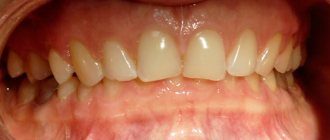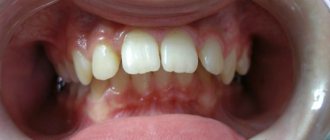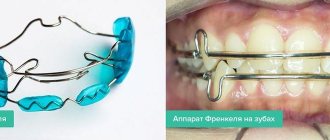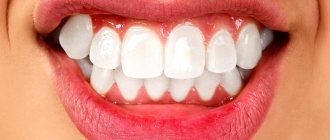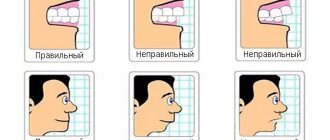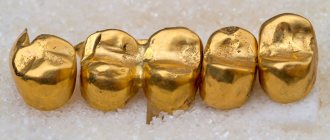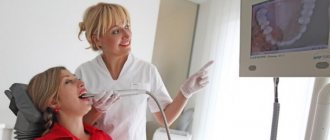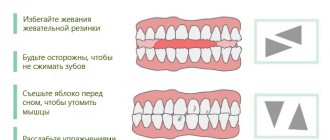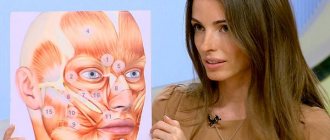4562
Discomfort in the cervical spine, headaches, snoring, tinnitus - this is not the entire list of symptoms that can be caused by malocclusion.
While the solution to these problems is carried out in the dentist's chair, by installing an orthotic, many patients seek salvation in the offices of other various specialists.
A special design, included in the list of neuromuscular dentistry techniques, makes it possible to influence not only the aesthetics of a smile, but also save the patient from certain diseases of the body.
A little about neuromuscular dentistry
Neuromuscular or, as it is also called, functional dentistry (NMS) is a whole science that studies malfunctions in the joints and muscles of the dental system. Based on the diagnostic results, industry experts suggest ways to solve the identified problem.
Under a malocclusion we are accustomed to accept the pathological arrangement of teeth. However, a certain violation of the aesthetics of the smile is the last consequence of improper interaction of the jaws.
Modern orthodontists offer to eliminate pathology by wearing various braces.
However, this treatment for malocclusion is incomplete, since disturbances in the functioning of the muscles and joints of the maxillofacial apparatus will not be corrected.
On the contrary, in some cases, artificially created pressure will aggravate the situation and the symptoms of the pathology described above.
Neuromuscular dentistry sets itself more global goals. CMS specialists care not only about the high level of aesthetics of the smile, but also about normalizing the relationship between the dentition, by restoring the proper functionality of the joints and muscles.
In European countries, this industry has existed for many years, but in our country there are still very few qualified NMS professionals.
But, according to experts, many orthodontists will adhere to the principles of work of neuromuscular dentistry specialists in the near future.
Additional information about functional occlusion is presented in the video.
The role of the masticatory muscles
The muscles that hold the lower jaw take part in the process of chewing food. They are responsible for raising and lowering it. The joint on which the teeth of the lower row are localized is called the temporomandibular joint (TMJ).
During food processing, muscles produce the necessary amount of energy for this process. If there is too much of it, they relax and return to their original position.
If a person has an incorrect bite, they cannot fully take the starting position. As a result, muscle spasm occurs, and as a result, limited movement of the TMJ.
The functionality of the masticatory muscles can be compared to working out in the gym. When you push yourself to the limit, the next day you find it difficult to move around.
During the continuous process of chewing food, the muscles become clogged with waste, and the jaw cannot open fully. This disorder leads to tooth wear.
Occlusal splint device
An orthotic is a transparent mouthguard, in most cases removable, and made of plastic, which is placed on one of the jaws of the oral cavity.
Another name for the design is an occlusal splint. Its placement depends on the specialist’s tasks. The severity of the pathological bite affects whether a removable or fixed orthotic will be installed.
The latter provide stationary fixation of teeth and regulate all occlusal functional loads. Their use does not interfere with speech and normalizes the chewing process.
However, to install them it is necessary to prepare the teeth. In addition, the design significantly worsens the hygienic condition of the oral cavity.
Depending on the design features and functional purpose, orthotics are divided into types:
- relaxation – provide a decrease in muscle tone and centralize the localization of the articular heads;
- decompression - used in the treatment of compression in the upper or posterior parts of the TMJ;
- stabilizing – create contacts between all teeth of the lower and upper dentition;
- positioning – change the pathological position of the teeth;
- repanning – return the dentition to its original position.
Patients should understand that the mouth guard is far from a prosthesis and causes slight discomfort when worn.
Functional and radiation diagnostic methods in orthodontics to identify anomalies of the dentofacial system.
Let's find out here whether macrodentia is an anomaly.
At this address https://orto-info.ru/zubocheliustnye-anomalii/zubov/formyi/konicheskie-i-shilovidnye.html you will learn how to correct awl-shaped teeth.
What is orthotic
Home / Articles / What is orthotic
Malocclusion is diagnosed in almost every patient, the only difference is in the severity of the pathology, when some people have such minor deviations that they can remain unnoticed throughout a person’s life, while in other patients the anomaly has a pronounced degree. Did you know that problems such as headaches, tinnitus, spasms, snoring, pain and discomfort in the cervical spine arise precisely as a result of malocclusion? A dentist with extensive experience, one of the best orthodontists, Mr. Anapa Farida Yusifovna Gasymova talks about the intricacies of the structure of the dental system and methods for correcting malocclusion today.
— Farida Yusifovna, how are neck pains and headaches related to teeth?
- Yes, indeed, it would seem they are not connected in any way, and many people think so, considering their own body and each organ separately, autonomously from others. In fact, in the human body, everything is not only closely interconnected, but each organ has its own influence on the functioning of the body as a whole. Disorders in the spine, for example, incorrect posture, affect the cardiovascular system, digestive tract, cause joint diseases and changes in the maxillofacial area. Conversely, problems with the dental system affect the health of the spine. Therefore, the modern approach to dental treatment takes into account not only the return of lost dental function and restoration of aesthetics, but an integrated approach that includes strengthening the spine, muscles and joints. If a patient has problems with the spine, the body muscles get used to the incorrect position and here one of the most important tasks of the doctor is to restore the correct amplitude of the muscles. In neuromuscular dentistry, orthotics are widely used - a special design that allows you to correct aesthetic and functional problems of the dental system. I want to emphasize that a problematic bite must be corrected, otherwise, in addition to an aesthetic defect, the patient develops a whole range of different problems: diseases of the temporomandibular joint, destruction of chewing teeth, numerous caries, gum disease, problems in the gastrointestinal tract, difficulty swallowing. With an incorrect bite, it is very difficult to carry out effective prosthetics and orthodontic treatment. Dentistry Millennium Anapa Mayakovsky offers residents and guests of the city professional bite treatment, accurate hardware diagnostics and complete restoration of the aesthetic component.
— Farida Yusifovna, tell us more about what orthotic is?
— An orthotic is a special dental structure used in neuromuscular dentistry; an orthotic is also called an occlusal muscle relaxant splint. The orthotic is installed to align both jaws in the anatomically correct position. An orthotic is, in fact, a mouthguard worn on the lower jaw. The orthotic is worn for several months so that the muscles and joints get used to the new position. Depending on the specific clinical case, a removable or non-removable orthotic is prescribed. To provide fixed fixation to the teeth and regulate functional loads, a non-removable device is used. A non-removable orthotic normalizes chewing function, while the patient’s speech does not change. To install the structure, the teeth are pre-prepared, and after a full course of treatment, restoration and orthodontic therapy are carried out. As a result of orthotic treatment, the jaw takes the correct shape and the teeth move to the anatomically correct position. A muscle relaxant splint or orthotic is prescribed by an orthodontist in Anapa after a thorough diagnostic stage. A dentist in Anapa not only conducts examinations and x-rays, but also uses hardware diagnostics of the dental system. In addition, if necessary, the Anapa orthodontist gives a referral to other doctors, for example, a gnathologist in Anapa, a neuromuscular dentist in Anapa, a surgeon, etc. If we talk about general factors for which wearing orthotics is recommended, then these are bruxism, impaired muscle function, dysfunction of the temporomandibular joint, the absence of one or more teeth, pathology of the joints of the masticatory apparatus, incorrect position of the lower jaw, insufficient bite height. How long it is necessary to wear an orthotic can only be determined by the attending orthodontist in Anapa, since depending on the specific clinical case, the duration of therapy can vary significantly. The orthotic differs in purpose and design features, the relaxation occlusal splint centralizes the position of the joints and reduces muscle tone, the decompression occlusal splint is indicated when diagnosing compression in the upper/posterior part of the temporomandibular joint; a stabilizing occlusal splint helps create correct contact between the teeth of the lower and upper jaws; The repanning occlusal splint ensures correction of the entire dentition into the correct position. I would like to note that many patients confuse an occlusal splint with an orthodontic prosthesis, and these are completely different things, so patients need to be prepared for the fact that orthotic therapy is accompanied by discomfort in the mouth.
— What can you say about the progress of therapy and what awaits patients during orthotic treatment?
“I can unequivocally say that you should not be afraid of an orthotic, there is nothing terrible in such treatment, moreover, the sooner the patient decides on therapy, the better it will be for him. Before prescribing treatment, the orthodontist in Anapa conducts x-rays and computed tomography to see the condition of the patient’s muscles and ligaments. The muscle monitor is used to relax the muscles so that the doctor can determine the correct physiological bite of the patient. The orthotic is made individually, according to the computer model of the patient’s teeth. The manufacturing stage of orthotic devices is key, since the success of treatment depends on a correctly manufactured design. When creating a model of an orthotic, a dental technician takes into account a number of factors, including the therapeutic prognosis, the design features of the future product, the rigidity of the orthotic, and the duration of therapy. Since orthotic treatment takes quite a long time, it is necessary that the product does not impede personal hygiene, does not create excessive discomfort or tension in the mouth, and does not injure soft tissues. One of the main advantages of treatment with an orthotic is complete relief from the symptoms of TMJ dysfunction; the design reduces the load on the joint and relaxes the muscles. An effective result can only be achieved if the patient constantly wears the orthotic without removing it. And, if there is a need to remove the product, the orthotic should be stored in a container with an antiseptic solution. If the patient carefully follows all the doctor’s instructions, the treatment result will be effective: the mandibular joint begins to function correctly, muscle pain goes away, the lower jaw takes on an anatomically correct position, chewing function is normalized, enamel abrasion is reduced, and the general condition of the oral cavity improves.
Comprehensive hygiene for 2500 rubles! Air Flow 1000p for patients with braces!
A unique promotion for our regular patients! A set of hygienic procedures (removal of tartar and plaque using Air Flow and ultrasound , scaling, polishing, fluoridation) for regular patients once every 6 months for RUB 3,000!
Air Flow and polishing for only RUR 1,500 for patients with braces!
Manufacturing
For the production of both removable and non-removable structures, hypoallergenic plastic is used, which is soft and elastic. The product is modeled to suit the individual characteristics of each patient’s dentition.
For this purpose, an X-ray examination (panoramic image) and computed tomography are prescribed, which allows you to assess the condition of the muscles and ligaments of the masticatory apparatus.
In addition, the correct physiological bite is studied by relaxing the muscles using a special device - a myomonitor.
First, the specialist makes an impression of the lower jaw, which is sent to the laboratory. Then a computer simulation of the jaws and the future structure is carried out based on the cast and panoramic X-ray.
When making a structure, a number of factors are taken into account:
- therapy plan;
- duration of treatment;
- product rigidity;
- design features that allow installation without creating tension in the oral cavity.
In addition, a plastic mouth guard should not injure the enamel or irritate the mucous membrane, or create hygiene difficulties.
What is dental enamel dysplasia and what methods are used to eliminate such anomalies in the structure of hard tissues?
In this publication we will talk about dental microdentia.
Follow the link https://orto-info.ru/sistemyi-vyiravnivaniya-zubov/lechebno-profilakticheskie-apparatyi/ortodonticheskie-treyneryi.html if you are interested in reviews about the orthodontic trainer.
What is
An orthotic is a dense transparent case that is made of dental plastic that does not react with saliva and does not emit harmful substances. It is placed on the lower jaw in order to correctly position the muscles and ligaments in relation to each other. This is expressed in a change in the position of the jaws.
The result of treatment is the movement of teeth into a given position, and all parts of the dental system should ultimately assume the desired anatomical structure. For this purpose, a removable or non-removable orthotic design is used. The choice depends on the indications, and it depends on the decision of the dentist.
The non-removable structure fixes the teeth motionless, limits the force of the load on the dentition and the articulation of the jaws. Normalization of chewing is observed, and diction does not suffer, which often occurs when using functional equipment. The downside is that the teeth must be prepared before installing a permanent orthotic. A non-removable appliance complicates hygiene procedures and therefore leads to new dental problems more often than a removable one.
Wearing
In general, experts recommend using an orthotic for several months. During this period, the structure prepares the muscles and joints for orthodontic systems or for restoration of dentition.
During the period of use of the orthotic, the symptoms of TMJ dysfunction weaken and almost completely disappear.
Wearing non-removable products is prescribed for the main treatment method in cases of serious impairment of neuromuscular functionality.
It is worth noting that the effectiveness of the structure’s operation is observed due to a reduction in the load on the mandibular joint and, accordingly, constant muscle relaxation.
When wearing the product, you must follow certain rules:
- The orthotic should be worn constantly, especially not removing the device from the oral cavity at night . The teeth of the lower and upper jaws must be in constant contact. At night, we involuntarily squeeze them when swallowing.
- You should not remove your orthosis before visiting the dentist. The structure should be in the mouth for half an hour at the time of sitting in the chair. This is exactly how much time is needed for the heads of the joint to take the correct specified position.
- Intentional pressure on the splint is not necessary if there is only a small amount of space between the teeth.
- The design must be present at every visit to a specialist.
- When removed, the product must be stored in a closed container filled with an antiseptic solution. This rule is very important, as this way you maintain the softness of the plastic.
- During hygiene procedures, it is necessary to brush not only your teeth, but also your orthotics. All you need is a regular brush and paste.
- Don’t forget to visit your dentist to correct the surface of the structure. Depending on the progress of treatment, the specialist may sand or layer the plastic.
It is necessary to follow the rules even if you do not observe significant changes.
Operating rules
The average time to wear an occlusal splint is six months. During this period, the muscles acquire new characteristics and are prepared for further treatment. Symptoms of weakening of the temporomandibular joint become less pronounced or disappear completely during this time. This effect is achieved due to a stable reduction in load.
To achieve this result, certain rules must be followed:
- For removable structures, you must follow the wearing regime and do not remove the structure unless necessary. During sleep, it should be left inside the oral cavity, since with hypertonicity, even at night, excessive load on the joint can be observed. This picture especially corresponds to bruxism.
- You must come to your dentist consultation with a splint on your teeth. This is necessary so that the doctor can evaluate the progress or changes that have occurred during the course.
- If there is a gap between the upper and lower teeth, then you cannot try to remove it by pressing on the lower jaw. Such forcing can lead to negative consequences. The dental arch needs time to acquire the desired shape.
- Removable structures must be stored in a special container with solution. This is necessary to keep the structure soft and elastic. In addition, the container will protect the orthotic from mechanical damage and contamination.
- When brushing your teeth, the occlusal splint is also cleaned. To do this, use regular toothpaste. It is prohibited to place the structure in hot water, as high temperatures can deform it.
- During the course you should visit your doctor at the prescribed intervals. This will allow you to detect all changes in a timely manner and, if necessary, adjust the treatment plan. Sometimes it is necessary to remove a layer of plastic or, conversely, add thickness to add rigidity.
Efficiency
The effectiveness of treatment is indicated if all the planned changes while wearing the orthotic have been achieved. An important role in this issue is played by the extent to which the neuromuscular system tolerates the presence of a foreign body in the mouth.
If the implementation of the plan requires a long service life of the structure, the presence of a foreign body in the oral cavity can provoke a number of diseases - periodontal pathology, loosening of teeth, numerous caries, TMJ dysfunction.
However, in most cases, wearing an orthotic:
- normalizes the functionality of the mandibular joint;
- reduces or completely eliminates muscle pain;
- ensures a healthy position of the lower jaw;
- modifies the trajectory of the joint during chewing;
- reduces the degree of enamel abrasion during bruxism;
- improves the condition of the oral cavity before installing braces or complete dentures.
Types of structures
Orthodontists distinguish several different types of orthotics. They differ slightly in design and are aimed at eliminating various deviations. Tires are as follows:
- Relaxation . They are used if the patient is diagnosed with stable hypertonicity of the masticatory muscles, which causes dysfunction of the joints.
- Decompression . Aimed at reducing pressure recorded in the posterior or upper parts of the temporomandibular joint.
- Stabilizing . The bite is brought into a state of normal contact between the upper and lower dentition.
- Positioning . Correct the position of teeth within the dental arch.
- Replicating . They are used when the entire row of teeth needs to be moved to the right place.
Like any orthodontic structure, when wearing an occlusal splint, the patient initially feels a certain discomfort, which decreases over time.
